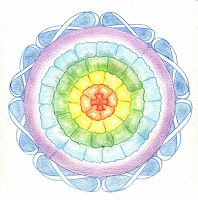Sunday, June 15, 2008
Vanitas
My Serendipity Piece

This unit, i thin has been about the concept of finding self, and life, and working with the cards you've been dealt. Our art piece for this unit was an ink work which we worked over in pencil creating rhizomes and mandalas, and becoming our very own Andy Goldsworthy. This piece really made me contemplate and reflect upon the ideas that had been presented to us during the unit, as in our final piece we were to create a symbol of self - and that is what the mandalas and rhizomes are all about.
For my final piece, I used a combination of the techniques. I mostly sprayed the paper with water and then added the inks. To move the ink I manipulated the paper, and i used a straw. The one and only thing that i found frustrating about the concept of Serendipity, was the lack of control you had over the outcome.
 These are some close up images of my final piece, courtesy of Mrs Vincent.
These are some close up images of my final piece, courtesy of Mrs Vincent.

Mandalas & Rhizomes

Serendipity

This was my first ink manipulation practice. I found the inks incredibly hard to control. They would run where ever they please, with me having very little say in the outcome. I do like this piece alot though. I like how all of the colours blend well. Up in the top left-hand corner it a blue dark spot that smudes out. This is an aspect I particularly like. I also like the sort-of-rhizomes that have been created in blue at the bottom of the page.
 This was my second practice with the inks. The technique I used involved immersing the paper in water, letting it drain off, and then dropping the different colours of ink at the bottom of the page. I then picked the paper up and let the inks run, creating the rhizomes. I like this ink piece as all of the colours blend, and I also like the fact that the rhizomes connect.
This was my second practice with the inks. The technique I used involved immersing the paper in water, letting it drain off, and then dropping the different colours of ink at the bottom of the page. I then picked the paper up and let the inks run, creating the rhizomes. I like this ink piece as all of the colours blend, and I also like the fact that the rhizomes connect.
 This is my third ink practice. For this piece i sprayed the paper with water using a spray bottle and then dropped the ink into the applied water. I then spread the ink using a straw. I did this first with the blue and found it hard and not very effective, only creating short rhizomes. I then tried again with the pink and yellow and found it more successful, creating long, continuous rhizomes.
This is my third ink practice. For this piece i sprayed the paper with water using a spray bottle and then dropped the ink into the applied water. I then spread the ink using a straw. I did this first with the blue and found it hard and not very effective, only creating short rhizomes. I then tried again with the pink and yellow and found it more successful, creating long, continuous rhizomes.
 This is my fifth ink practice. This is probably one of my favourite piece's. I love the effect that the technique I used created. To achieve this I sprayed the paper with water using a spray bottle and then dropped the inks into the water. I then spread the ink in the splattered effect by further spraying the inks with water from the spray bottle. I aslo liked the way that this technique blended the colours together well. I also felt that this technique gave me a tiny bit more control over the outcome.
This is my fifth ink practice. This is probably one of my favourite piece's. I love the effect that the technique I used created. To achieve this I sprayed the paper with water using a spray bottle and then dropped the inks into the water. I then spread the ink in the splattered effect by further spraying the inks with water from the spray bottle. I aslo liked the way that this technique blended the colours together well. I also felt that this technique gave me a tiny bit more control over the outcome.
Baraka
Baraka depicts footage of various landscapes, chruches, ruins,religious ceremonies, and cities thrumming with life. Baraka was filmed using time-lapse photography inorder to capture the great pulse of humanity as it flocks and swarmsn in daily activity.
Baraka searches for a universal cultural perspective: for instance, following a shot of an elaborate tatto on a bathing Japanese mobster with on of Native Australian tribal paint.
The movie was filmed at 152 locations of 24 countries: Argentina, Australia, Brazil, Cambodia, Chine, Ecuador, Egypt, France, Hong Kong, India, Indonesia, Iran, Israel, Italy, Japan, Kenya, Kuwait, Nepal, Poland, Saudi Arabia, Tanzania, Thailand, Turkey, and the United States of America.
Here are some scenes from the movie...


Andy Goldsworthy
Andy Goldsworthy was born Jul 26, 1956. He is a british sculptor, photography, and environmentalist living in Scotland. His art involves the use of natural & found objects to create both temporary and permenamt scultures which draw out the character of their environment. This means that his work is ephemeral: meaning that it doesn't last
 These are some images of a permenant piece of Goldworthy's, the Neuberger Cairn.
These are some images of a permenant piece of Goldworthy's, the Neuberger Cairn.



